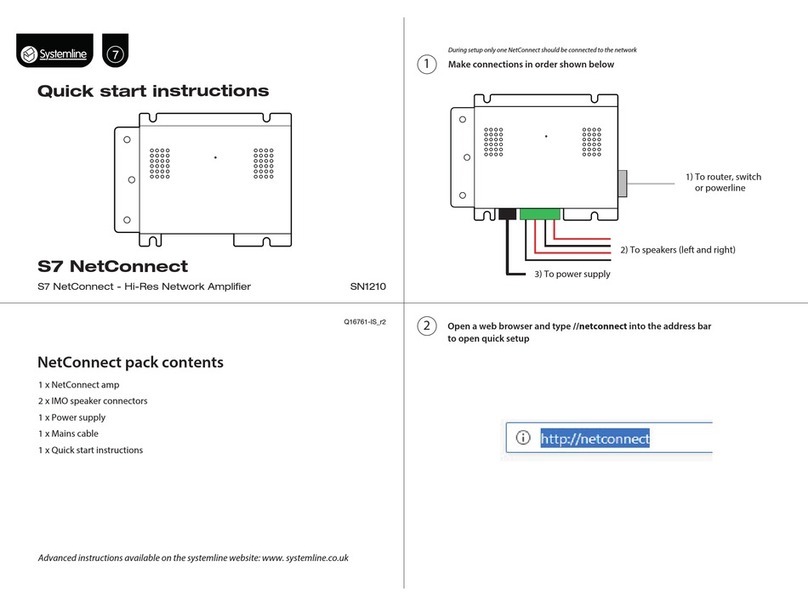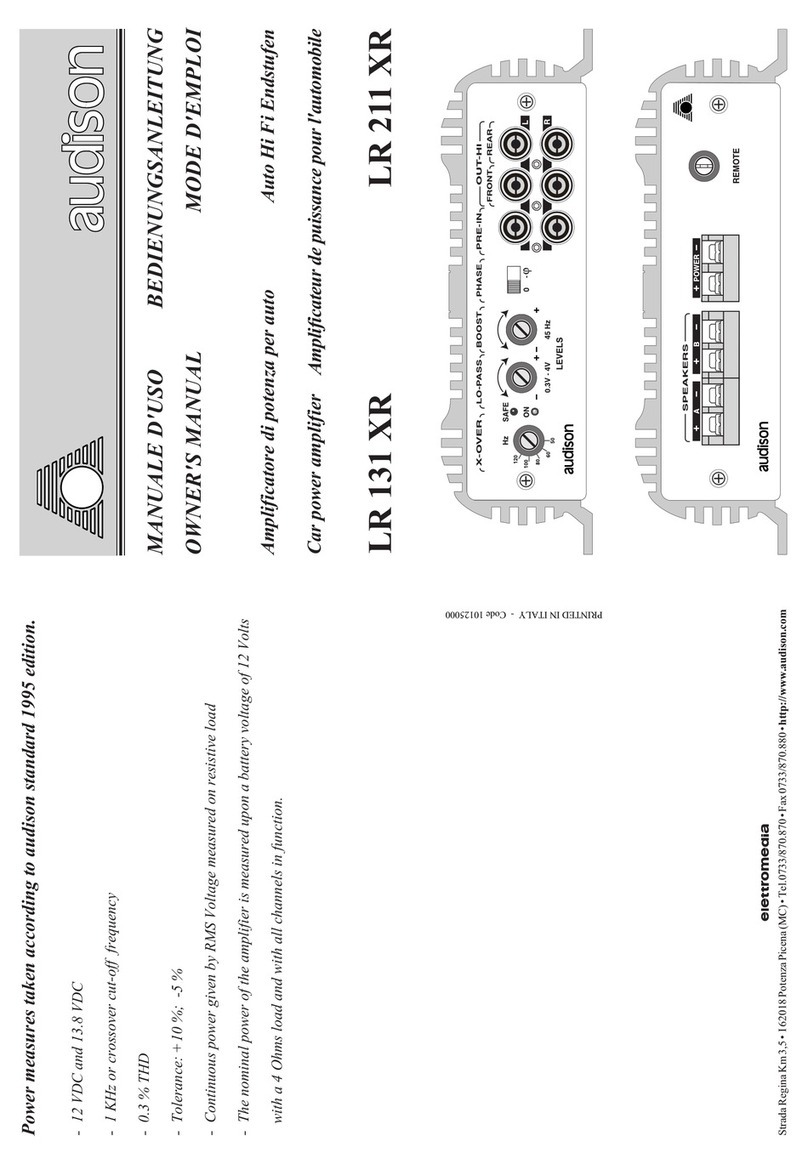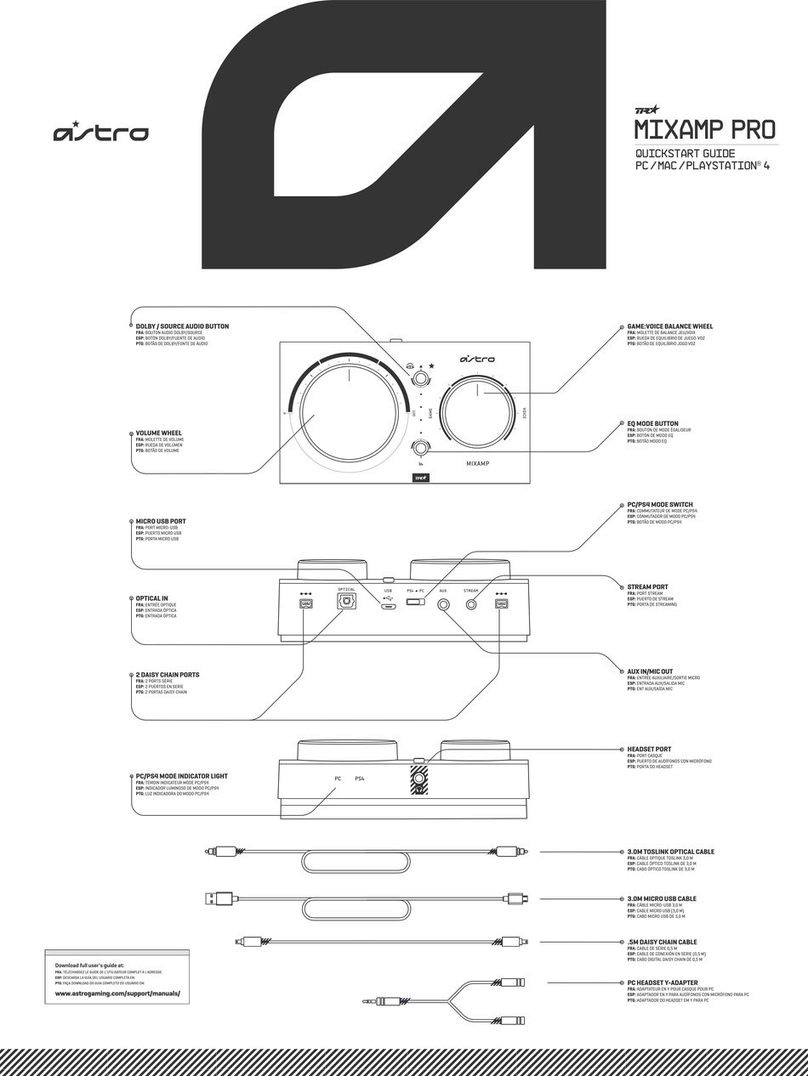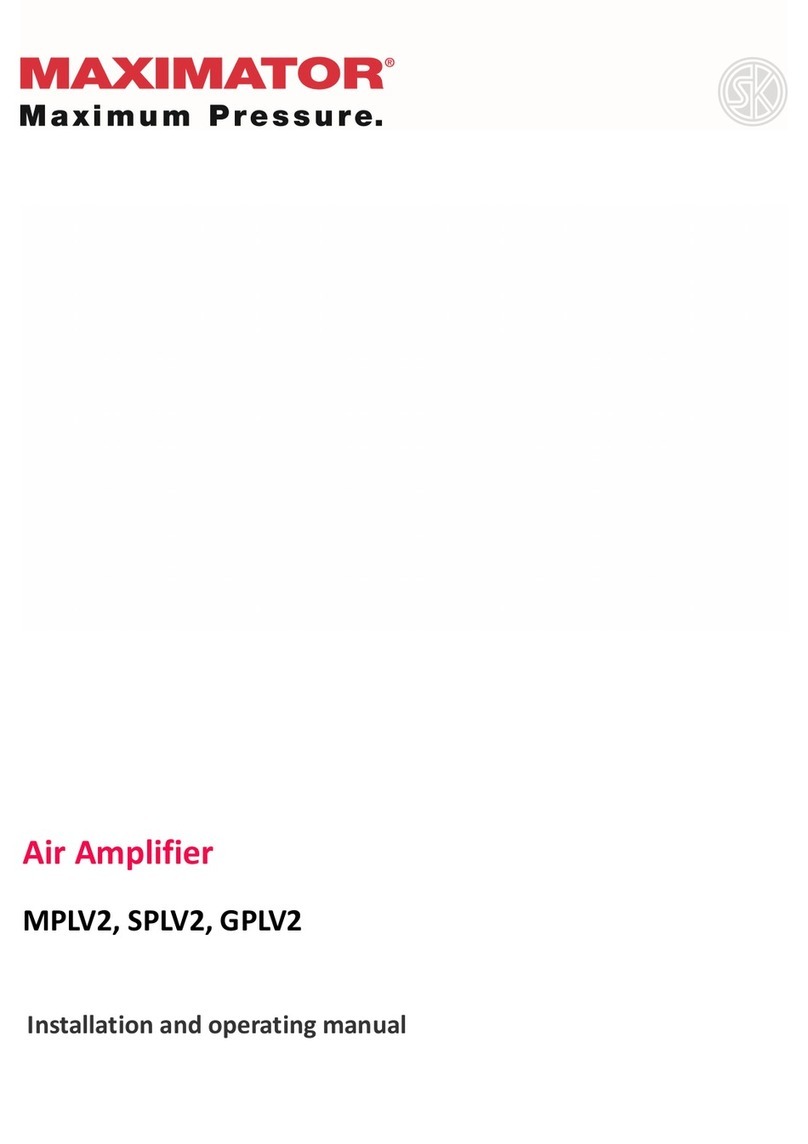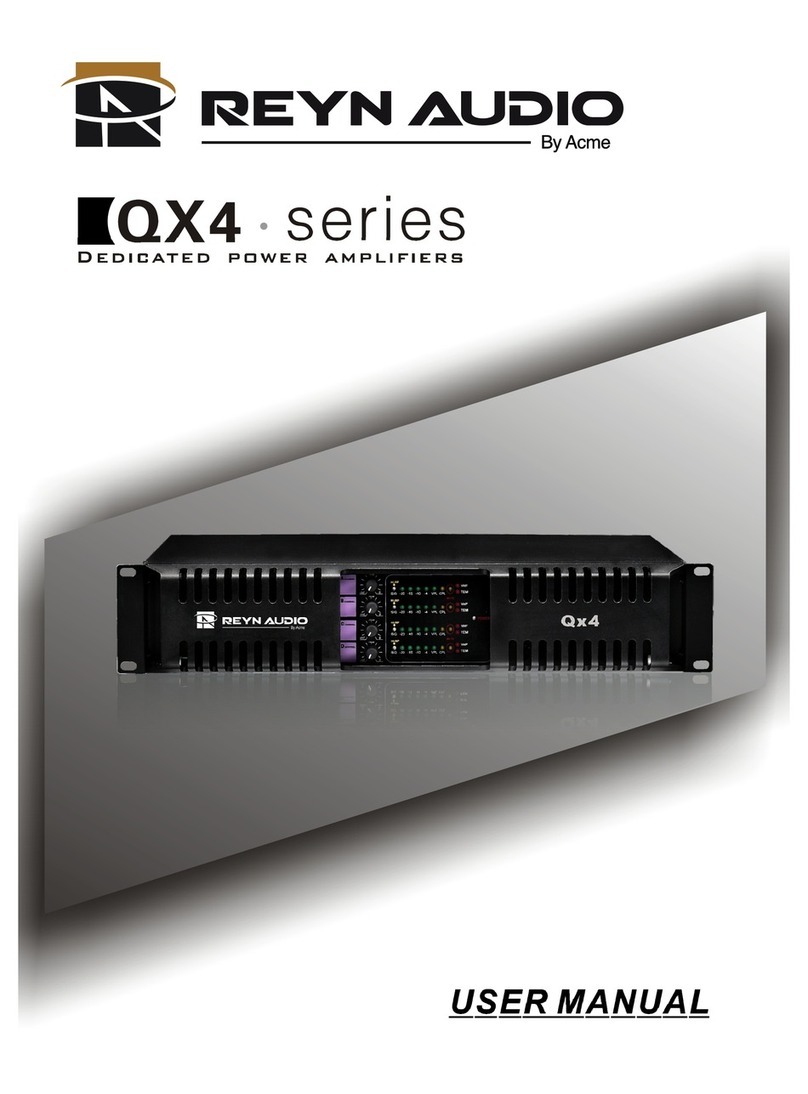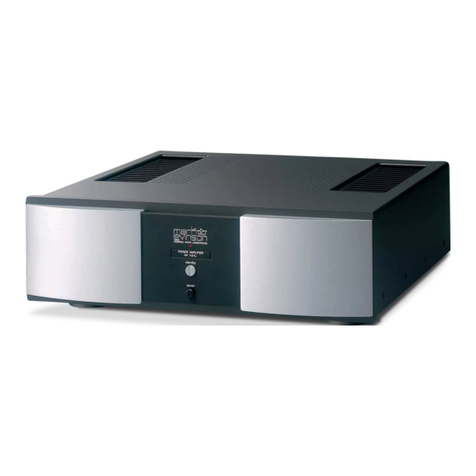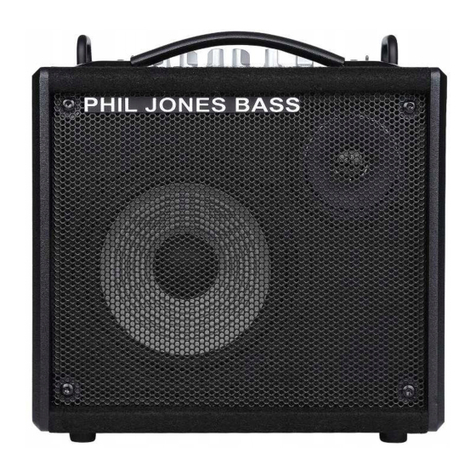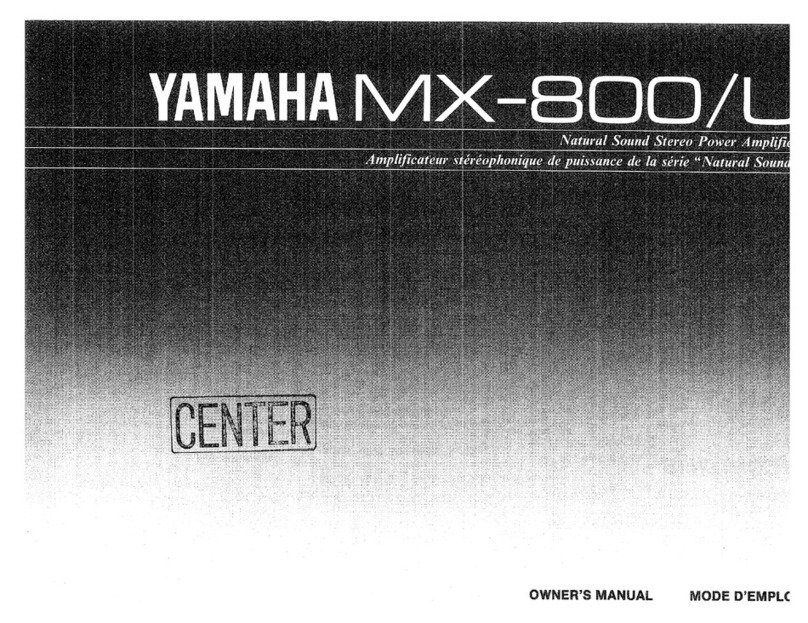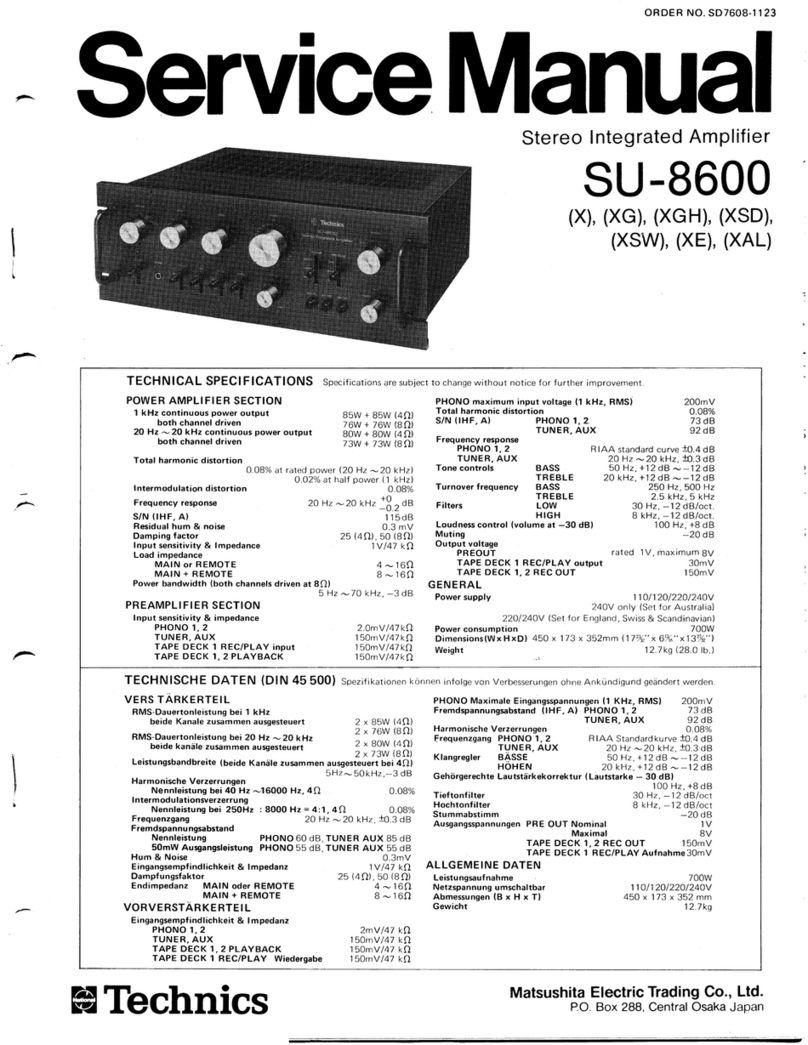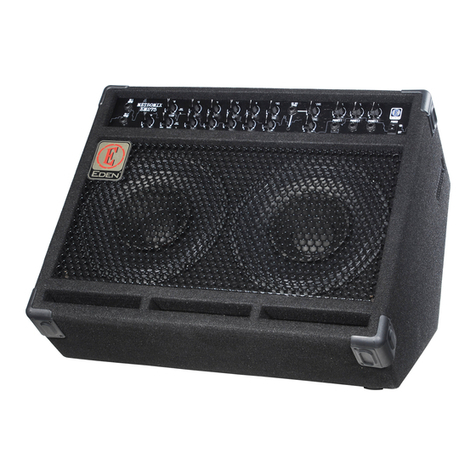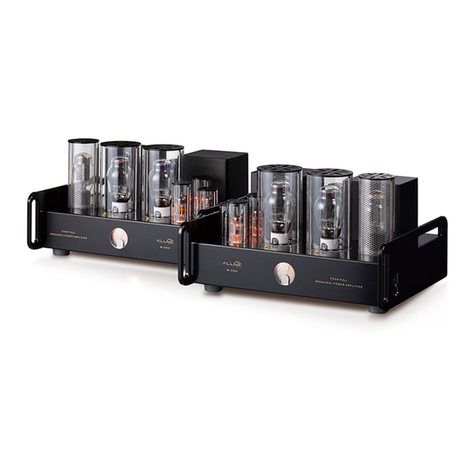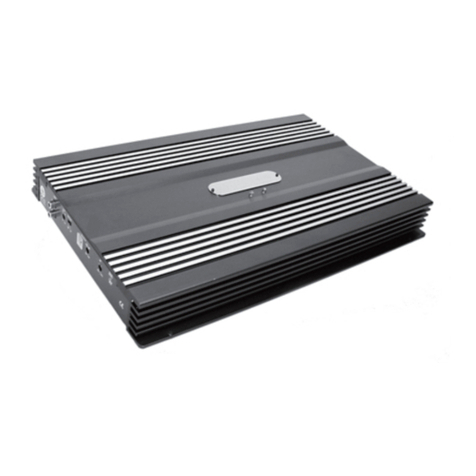Architect 1600 SE User manual

ARCHITECT
Model 1600 SE
Model 1601 SE
16 Channel
High Current
Power Amplifier
Speaker Optimizer
Professional Installer’s
Consciousness Guide
22410 70th Avenue West
Mountlake Terrace, WA 98043 USA
425-775-8461 • Fax 425-778-3166
www.audiocontrol.com
®
For Those Who Consider Perfection Possible®
©2007. All rights reserved.
tm

®
Important Information
Dealer Name________________________________________
Date Installed _______________________________________
Serial Number_______________________________________
Ethernet MAC Address _______________________________
IP Address Dynamic / Static___________________________

ARCHITECT
Model 1600 SE
Model 1601 SE
Installer’s Guide
™
CONTENTS
The Architecttm ProductHighlights.......................1
Experienced Installer’s Quick Hook-Up Guide . . . . . . . . . . . . . . 3
A Guided Tour Of The Architect. . . . . . . . . . . . . . . . . . . . . . . . . 4
HookingUpYourSystem ..............................7
Installation: The Long Version. . . . . . . . . . . . . . . . . . . . . . . . . . . 8
Placement.......................................8
Power..........................................9
RemotePowerControl.............................9
AudioHook-Up.................................10
Speaker Hook-Up ................................13
EqualizingtheSystem................................14
EqualizationControls.................................15
A Short Introduction To Equalizers And Acoustics . . . . . . . . . . 16
Audio Analysis Using Pink Noise . . . . . . . . . . . . . . . . . . . . . . . 17
What’sInside.......................................18
The Truth About Bass and
The Programmable Frequency Match Filter . . . . . . . . . . . 18
Patented Intelligent Power Supply . . . . . . . . . . . . . . . . . . . 18
LightDrive ProtectionSystem ......................19
UsingtheEthernetPort...............................20
Troubleshooting.....................................23
A Brazen Plug For Other AudioControl Products . . . . . . . . . . . 25
Appendices
Appendix A
Bridging The Architect . . . . . . . . . . . . . . . . . . . . . . . . . . 26
Appendix B
Using the Ethernet-Based Automation Systems . . . . . . . 26
TheWarranty.......................................28
ServiceInformation..................................29
BlockDiagram......................................30
Specications .......................................31

®
The Architect Model 1600 SE, Model 1601 SE

ARCHITECT
Model 1600 SE
Model 1601 SE
Installer’s Guide
™
Product Highlights
1
Congratulations!
You are now installing a component which can dramatically
improve the performance of any distributed audio system, espe-
cially those utilizing in-wall speakers. The Architect™ Model
1600 SE Series is an American-designed and built, “set and
forget” component which will provide a lifetime of trouble-free
service for your multi-room audio system.
The Architect™ Model 1600 SE Series is made by the only
electronics company in the world that specializes in ampliers,
equalizers, signal processors and audio analyzers. And the com-
pany whose professional sound division designed and sells the
most popular one-third octave real time analyzer in the world, the
SA-3050. AudioControl’s passion for high quality, meticulous at-
tention to detail and pro sound heritage shows itself in the dozens
of awards we have won for our designs, products and service.
Now, as when we began, our greatest satisfaction is our reputation
for sonic excellence and reliability among people just like you
throughout the world.
This manual is designed to help you get everything you can
out of your new amplier. So, even though you’re dying to see it
in action, please take a few minutes to slog through our not-so-
weighty prose and learn how to get the most from The Architect
power amplier. Anything as capable as this amp deserves all the
explanation it can get.

®
Product Highlights
2
Cool Running - Distributed audio systems can place terric de-
mands on a home’s AC power. Sometimes just a little brownout can
cause an amplier to pull enough current to blow the house circuit
breaker. Even when they’re running properly, most ampliers put out
enough heat to make any air conditioning system sweat. AudioControl
takes care of these problems with our patented (US Patent #5,708,577)
power supply regulation and Class-H amplier design. Both of these
features combine to create one of the most reliable and efcient audio
ampliers available. Higher efciency means a cooler running ampli-
er. The advanced power supply regulation also minimizes circuit
breaker-popping in-rush currents.
Built For The Long Haul – The Architect™ Model 1600 SE
Series has been designed with durability in mind. The LightDrive
protection circuitry defends The Architect™ and your speakers against
clipping, distortion, damage, and even teenage parties. Even if the party
lasts all weekend. Each channel pair is independently protected so a
problem in one channel will not affect the rest of the system.
Specially-Designed Equalization Controls – (Model 1600 SE and
Model 1601 SE) The Architect™ Model 1600 SE Series is intended to
provide a dramatic sound improvement for “small” speakers, such as
those with 6-inch and 8-inch woofers. The Architect’s 75Hz, 250Hz,
700Hz, 2500Hz and 12KHz band centers were chosen to optimize in-wall
and 2-way bookshelf speakers at critical frequencies where adjustment is
most advantageous. The bandwidths (or ‘Q’ as our engineering types call
it) have also been optimized for the difculties that in-wall speakers pres-
ent. This allows The Architect™ Model 1600 SE Series to improve the
sound of these smaller speakers better than any other equalizer.
PFM Subsonic Filter –The Architect’s Programmable Frequency
Match (PFM) circuitry is a bass-blocking 40 Hz lter which protects
small speakers and improves their overall sound. It gives small woof-
ers only those frequencies they can use by “chopping off” bass below
40Hz. The woofer is protected and can do a better job of reproducing
mid-bass and higher frequencies.
Ethernet Network Compatible – ( Model 1601 SE) The power of
the Internet is built into the Architect. This internal web server provides
remote service diagnostic capabilities and enables the system integrator
to control this amplier via Ethernet.
Made in the Northwest Rainforest – The Architect™ Model 1600
SE Series began its existence at our factory in Mountlake Terrace,
Washington, a few miles north of Seattle. Here, we also build precision
test instruments, equalizers, analyzers and a totally awesome line of car
stereo components. AudioControl started in 1977 and has won so many
audio industry awards for design and engineering excellence that our
reception room wall is starting to sag. But enough about us, let’s start
getting the most from the audio system!

ARCHITECT
Model 1600 SE
Model 1601 SE
Installer’s Guide
™
Quick Hook-Up Guide
3
Experienced Installer’s Quick Hook-Up Guide
What follows are “Express” hook-up diagrams for profession-
als and experienced audio buffs.
The PFM bass-blocking lter comes factory set to 40Hz.
Don’t be afraid of leaving this lter turned on. We have found
over the years that a system actually sounds louder and has more
bass when the subsonic lter is used in the system.
Final adjustment of The Architect™ Model 1600 SE or Model
1601 SE’s speaker optimizer controls is best done with a one-
third octave real time analyzer and pink noise test signal, but it
can be done by ear, especially if you desire to emphasize certain
frequencies.
One nal note: Make certain the warranty card is lled out
and mailed back to our factory. Comments received from these
warranty cards are one of the ways we keep improving our prod-
ucts.
Quick
Installers Checklist
Do any zones have
more than 2 speaker
pairs? – See Input Bus-
sing page 10.
Are there any odd
shaped rooms (like
Bathrooms) or outdoor
spaces? – Try using the
Mono feature Page 5.
Do you need more than
60 watts to a speaker?
– Refer to Amplier
Bridging Appendix A.
Using the Ethernet
Control? The default IP
address for the browser
is http://192.168.0.1
Refer to Appendix B.

®
Front Panel
ÊStereo Speaker Equalization Controls - This
array of knobs provide up to 12dB boost or cut
at 75Hz, 250Hz, 700Hz, 2500Hz and 12KHz.
After initial adjustment the only time you
would change the control settings are 1) if you
connect different speakers into the system, 2)
if (assuming the speakers aren’t built-in) you
move them signicantly, such as from a book-
shelf to oor stands, or 3) if your room acous-
tics change through addition or rearrangement
of furniture, wall or oor coverings, large hairy
dogs, etc.
ËChannel Status LED’s - These dual-color
LED’s serve two purposes. First they illumi-
nate Blue when the corresponding channel is
active. The second function of the status LED
is to turn Red if something has caused that
zone to go into protection.
4
ÌProtection LED - This LED also has two
faces. In normal operation it glows Blue when
the remote power trigger is active and the
Architect is in stand-by. If the Protection LED
turns Red, then one of the internal protection
circuits have come into use. All the protection
circuits automatically reset themselves when
the problem causing the fault has been xed.
ÍPower LED - Nothing too tricky here...when
you have the Master Power switch on the back
panel turned on and the Architect is plugged
into an active AC outlet, this little Blue light
will shine forth.
Ì Í
Ê Ë
Model 1601 SE
A Guided Tour Of
The Architect™ Model 1600 SE Series

ARCHITECT
Model 1600 SE
Model 1601 SE
Installer’s Guide
™
5
A Guided Tour Of
The Architect™ Model 1600 SE Series
more rear panel features on the next page
Í Ì Ð Ñ
Ê Ë Î Ï
Rear Panel
ÊEthernet LAN Connection (Model 1601
SE) – This enables control of the Architect via
a standard 10BaseT computer network. The
internal web server of the Architect also allows
the technician to remotely monitor the status of
the amplier.
ËBypass Switch (Model 1601 SE) – For
diagnostics only. This button disables all the
Ethernet control functions and forces all chan-
nels on. This is useful in case there is a prob-
lem with the home automation system and you
really need some music.
ÌSignal Sense Defeat - The signal sensing
circuitry activates a zone when a signal is pres-
ent. To leave the Architect ready to play at all
times, press this switch in (to Defeat).
ÍBus Inputs 1 and 2 - These RCA inputs
provide two distribution busses to provide a
common signal to multiple zones. These inputs
are used in conjunction with the Bus Input
Switches on each amplier zone.
ÎSpeaker Outputs - These terminal blocks
are designed to make an installer smile. You
can unplug the blocks and connect all of the
speaker wires to them without balancing the
Architect on your lap. This also makes it very
simple to pre-wire a system.
ÏLocal Trigger Inputs – This 1⁄8” mini-jack uses
an external 12 volt trigger to switch the zone
between the bus input and the local zone input.
This is great for switching a room between the
whole-house audio signal and a local source
such as a television. The LED next to this jack
indicates when the trigger is active.
ÐMono – This button sums (Monos) the left and
right inputs of the selected zone. This button
is active when pressed in and does not affect
any other zones. The Mono feature is also used
when you are bridging a zone.
ÑInput Level Control – This screwdriver
adjustment controls the input sensitivity of the
Architect amplier. The minimum sensitivity
(full clockwise)is 1 volt.

®
6
ÒPFM Highpass Filter –
This bass blocking lter
sets the low frequency cut-off point of the Archi-
tect. The PFM lter is 18dB per octave and the
frequency is xed at 40Hz. When this button is Out
(defeated) the channel passes full range to the zone.
ÓBus Select Switches – These two buttons next
to each zones local input jacks selects the input
source for that amplier zone. If both buttons
are Out, the zone receives signal from the Local
Input. If the Top #1 Bus button is pressed, the
zone source is Bus Input #1. When Both Bus #1
and Bus #2 buttons are depressed, the zone source
is Input Bus #2. Whenever a Bus Input is selected,
the zone input can be remotely triggered to the lo-
cal input using the 12 volt Local Trigger input (see
#6 on previous page).
Local Inputs - These unbalanced RCA inputs
connect to your preamplier’s outputs. Any stan-
dard line level audio signal can be connected to
these inputs.
AC Power Fuses - The Architect is designed with
several layers of protection circuitry. These main
AC power fuses are here just in case something
really awful goes wrong. There are no internal
fuses in this amp.
Power Cord The Architect™ draws a maximum
of 1600 watts at full power. Make certain that it
is plugged directly into the wall outlet or a power
strip with sufcient power rating. Since the Archi-
tect has remote power switching, you should plug
the unit into an AC outlet that is always active.
Master Power Switch - This switch shuts off the
main AC power. Normally the only time you need
to turn the master power switch off is if the system
is going to be shut down for an extended period of
time.
Remote Power Control - This three pin connector
allows you to remotely turn on the Architect. You
can either use a contact closure between the Trigger
In and the +12V output or an external 12 volt trig-
ger between the Control In and Ground terminals.
The +12 volt output is not designed to power other
pieces of equipment.
Ground Lift Switch – This switch selects the
level of isolation between the audio signal ground
and your AC earth ground. In normal operation
this switch should be in the Ground position, but if
you run into trouble with an AC ground hum, try
the other two settings for the best operation. For
your safety, the chassis is always connected to the
earth ground regardless of the switch setting.
A Guided Tour Of
The Architect™ Model 1600 SE Series
Ò Ó
11 1615141312
12
11
13
14
15
16

ARCHITECT
Model 1600 SE
Model 1601 SE
Installer’s Guide
™
7
Hooking Up Your System
What you’ll need:
1. The Architect™ Model 1600 SE Series Amplier.
2. RCA audio hook-up cables.
3. Small blade screwdriver for terminal blocks
4. (Optional) A balanced line driver (of course we recom-
mend the AudioControl BLD-10 and BLR-10) if you are
going to mount the Architect more than 20 feet from the
preamp.
5. Enough speaker wire to reach all of your speakers.
6. Multi-zone audio controller, receiver, or preamplier.
7. Although you can set the speaker optimization controls
by ear, a real-time audio analyzer such as the
AudioControl Industrial SA-3052 is very helpful.
8. An RJ-45 10BaseT Ethernet connection cable.
(Optional - Architect Model 1601 SE)
Hooking Up Your
System
BLR-10 and BLD-10 Balanced Audio Drivers send audio over CAT-5. Extends
high quality audio up to 1000’.
SA-3052

®
Installation:
The Long Version
8
Installation: The Long Version
What follows is a step-by-step guide to integrating the Ar-
chitect into your multi-zone system. If it seems overly detailed,
please forgive us. We would rather tell you too much than too
little.
First, check your new Architect for any shipping damage. We
pack ‘em pretty securely, but it’s a vicious world out there and
anything can happen between us building them here in Mountlake
Terrace, Washington and your installation.
PAPERWORK
Yes, lling out the warranty registration card is about as excit-
ing as cleaning out your sock drawer, but we’d denitely like the
card back after you’ve hooked up the Architect and played with it
a while. We DO read each and every incoming card and react to
your suggestions. That’s how great products like this are created.
Next, record the serial number on the sales receipt and make
certain the home owner puts it away in a safe place. Stashing the
receipt away is very important in the unlikely event that your
Architect ever needs servicing, or…well things do happen…you
need to prove to an insurance adjuster that something as great as
the Architect was installed in the system.
PLACEMENT
The Architect™ Model 1600 SE Series is a very efcient
amplier, but it does need some breathing room to operate prop-
erly. Make certain that the air vents on the rear and sides of the
Architect are not blocked and have at least ½” of air space. Also
make certain that heat sensitive components such as CD or Tape
players are not directly on top of the Architect. Just as a reminder,
you should avoid putting any leaky pipes above the audio equip-
ment stack.
A benet of having remote power control on the Architect is
that you can install it in another area of the house (such as a base-
ment or utility room) away from the main component stack. Make
certain that you use a good quality audio line driver to extend the
RCA cables if you choose this type of installation.

ARCHITECT
Model 1600 SE
Model 1601 SE
Installer’s Guide
™
Installation:
The Long Version
9
POWER
Under normal operating conditions, the Architect Model 1600
SE Series can draw up to 1600 watts of AC power. Don’t plug it
into a switched outlet on your system unless you are certain that it
can handle the power rating. Also, please don’t cut off the ground
pin on the power connector. It is an important safety feature. If
you need to plug it into a two prong outlet, use a ground adapter
(and connect the ground on it). If you have a ground noise prob-
lem, try the ground lift switch on the rear panel.
REMOTE POWER CONTROL
The Architect has several means of power control:
1) Main AC Power switch- This is the master control and
must be turned ON for the Architect to function. When the main
power switch is on, the blue Power LED on the front panel lights
up. Normally the only time that you would need to turn the AC
power switch off is when the system is going to be unused for an
extended period.
2) Remote 12 volt Power Trigger - This removable 3-pin
remote connector on the rear panel allows simple interfacing with
external control systems. It accepts either a contact closure or ex-
ternal +12 volts DC. (see diagram) The two-color Protection LED
on the front panel illuminates Blue to show that the remote power
control is active.
3) Ethernet Control - If you have the Architect Model 1601
SE with the Ethernet control port you have remote control over
the amplier’s power from almost anywhere in the world via the
Internet. This is also very useful on a more local sense for inte-
grating the amplier with a home automation system via Ethernet.
4) Signal Sensing - Another level of amplier control is the
Signal-Sense circuitry. This provides individual channel muting
control. When active, it senses that an audio signal is present on
the RCA inputs then enables the power and unmutes that zone.
The zone status LEDs on the front panel light up Blue when a
signal is present.
In some installations it may be desirable to defeat the signal-
sense control and leave all zones active regardless of the audio
input. To defeat the signal-sense, press in the Signal-Sense Defeat
button on the rear panel
Installation Hint: If your
installation doesn’t require
this remote power turn-on, you
must put a short piece of wire
between the +12 V
output and the
Trigger In pins.
Warning - Always
connect the safety
earth ground. If
you have an AC
hum problem, use the ground lift
Note: Do not use the 12 volt
power trigger if you are using the
ethernet control. The power turn
on is controlled by the ethernet

®
10
AUDIO HOOK-UP
If you’re an installation veteran, this may seem repetitive, but
some things can never be repeated too many times.
1) Turn off ALL components before making any connections.
2) When making connections, designate RED RCA plugs as
RIGHT and WHITE, BLACK, or GREY plugs as LEFT. In
fact, this is a good idea for ALL signal connections made in
your audio system. The key is consistency. Stick with the same
color-coding and you’ll reduce possible problems.
3) Whenever possible, keep power cords away from signal cables
to prevent induced hum. This is especially important if you
bundle the cables to keep the installation neat looking.
4) Use quality interconnect cables. We’re not going to get into the
debate about whether $100/meter cables improve the sound,
but we know from experience that really, REALLY cheap
cables can cause a multitude of problems. They tend to break
inside or corrode, causing a loss of signal or hum. They also
have poor shielding.
5) If you need to run the RCA audio cables more than 20
feet you should consider us-
ing a balanced line driver for
the signals. This will provide
better noise rejection against
nasty things like hum, spikes,
local talk radio, etc.
The AudioControl
balanced line driver
components (BLD-10,
BLR-10 and BLX-10)
are an excellent way to
send audio over long
distances with standard
Cat-5 wiring. Check
them out.
Installation:
The Long Version
Using Bus Inputs
to Create Larger Zones

ARCHITECT
Model 1600 SE
Model 1601 SE
Installer’s Guide
™
WHOLE HOUSE SYSTEM WITH
TUNER ONLY BACKGROUND MUSIC
11
Installation:
The Long Version

®
12
Installation:
The Long Version USING THE 12V TRIGGER FOR
LOCAL SOURCE SELECTION

ARCHITECT
Model 1600 SE
Model 1601 SE
Installer’s Guide
™
SPEAKER HOOK-UP
The same rule applies to the speaker wires as the RCA con-
nections. Establish a standard connection color code and stick
with it. One conductor of the speaker wire is normally marked
by a different color (silver versus copper) or there is a ribbing on
one side. Typically this marked conductor is used for the positive
(+) speaker leads. Of course the really good wire has Positive and
Negative printed right onto the wire jacket.
Your choice of speaker wire gauge and the length of the runs
also affects the speaker impedance load presented to the ampli-
ers. As you can see in this table, even fairly short speaker runs
can have signicant resistance if you use a smaller wire gauge.
This can be a benet if you are paralleling lots of speakers. The
wire itself acts as an impedance limiter, since the amplier can-
not see a speaker load lower than the resistance of the wire. The
downside of this resistance in the wire is that you waste some part
of the total power available to the speakers.
See the appendix for information about bridging the Architect
into mono operation.
Congratulations! You’re done with the audio hook up. Now
for the details of operation…
Speaker connection wiring
Installation:
The Long Version
25’ 50’ 100’ 250’ 500’
24 GA 1.3 Ω2.6 Ω5.1 Ω12.8 Ω25.7 Ω
22 GA 0.8 Ω1.6 Ω3.24 Ω8.1 Ω16.0 Ω
20 GA 0.5 Ω1.0 Ω2.0 Ω5.0 Ω10.1 Ω
18 GA 0.3 Ω0.6 Ω1.28 Ω3.2 Ω6.4 Ω
16 GA 0.2 Ω.4 Ω0.8 Ω2.0 Ω4.0 Ω
14 GA 0.1 Ω.25 Ω0.5 Ω1.26 Ω2.5 Ω
12 GA 0.08 Ω.16 Ω0.32 Ω0.8 Ω1.6 Ω
13
Speaker Wire Resistance Wire Gauge versus Run Length

®
Equalizing the System
Equalizing the System
Before proceeding on to setting up the Speaker Optimization
controls on the Architect, it’s a good idea to make sure that you
have everything connected and working properly.
1. Double-check all connections. Make certain that all of the
audio and speaker connections are rmly seated and tightened
down.
2. Turn on your audio system. The Power LED on the Architect
should be Blue, the Protection LED should be Blue (after a
few seconds of Red on startup) and (unless you have defeated
the Signal-Sense) the Channel Status LEDs should be off.
3. Start one of the audio sources playing and send that signal
to the Architect (how you do this depends on your particular
multi-room system). The zone status LED should illuminate
Blue within one second after the music begins.
4. Check each speaker output zone to ensure that each one plays
properly.
5. With all the speaker loads turned on, turn up the volume and
make certain that the channel status LEDs on the Architect stay
Blue. If they slowly toggle between Blue and Red, then there
is either a short in the speaker wiring, or the combined speaker
load is too low.
Congratulations! You’re ready to go on to setting the Speaker
Optimization controls.
The following are examples of typical settings of the
Architect™ Model 1600 SE Series Speaker Optimizer
controls. Naturally, the results of adjustments will vary de-
pending on the individual acoustic environment, the type
of speakers, and the personal preferences of the listener.
These recommendations are not concrete, they are simply
good starting points.
Note: For the absolutely
best results, The speaker
optimizer controls on the
Architecttm Model 1600 SE/1601 SE
should be adjusted with a real time
analyzer such as the AudioControl
Industrial SA-3052.
14
Example Settings
SA-3052

ARCHITECT
Model 1600 SE
Model 1601 SE
Installer’s Guide
™
Equalization Controls
Here is a brief introduction to each of the Speaker Optimiza-
tion control frequencies and what their affect on your music is.
75 Hz – Bass. This is at the bottom end of the frequencies
which typical in-wall and small bookshelf speakers can achieve.
Even though the Architect’s PFM lter cuts frequencies under
40 Hz, boosting this band more than 6 dB can cause distortion.
Adjust this band with care. A mild boost will enhance bass instru-
ments such as bass guitar, kick drum, oor toms, timpani and
double bass violas.
250 Hz and 700 Hz — High and low midrange. These con-
trols directly affect the sound of instruments and vocals. These
bands also determine the speaker’s presence (whether the music
sounds far away or close in). Small speakers often produce too
much midrange, so these controls are candidates for being turned
down slightly during your initial experimentation. Denitely
consider reducing 700 Hz if you are only using your extension
speakers for background music.
2500 Hz — Treble. Female vocals and the “edge” of instru-
ments such as guitars, snare drums, saxes, violins, etc. are found
in this range. If accentuated too much (by boosting this control)
sounds in the 2500 Hz range can seem harsh and fatiguing to the
ear due to excessive output by the speaker or because of live,
reective room acoustics.
12 KHz — High treble. The ne detail, texture and sheen of
music is found here. The breathiness of vocals, the sheen of cym-
bals, the high overtones of piano and strings. Actually, there’s au-
dible music information up to 20,000 Hz on some CD’s and most
adult’s hearing is still pretty good at 15,000 Hz. But we’ve chosen
12,000 Hz because it provides more useful control to compensate
for room acoustics and common small-speaker deciencies.
Equalization Controls
15

®
A Short Introduction To Equalizers And Acoustics
Magazine reviewers and audio system owners spend much
time critically appraising speakers and other stereo components.
Unfortunately, a phenomenon that has a very large effect upon
sound is not easily judged or changed. That effect is the ACOUS-
TICS of the environment in which you are listening.
Room acoustics is a complicated subject about which entire
textbooks have been written. We simply want you to be aware of
a few basics that have a direct effect on real time audio analysis.
As you probably learned in
junior high school, sound trav-
els in waves. In a stereo sys-
tem, these waves are created
by the speakers. Like waves
in a pond created by a splash,
sound waves emanate from
the transducers (speakers) and
spread out into the room. If
your room were innitely big,
that’s all there would be to it.
But just as waves in a pond
reach the bank and reect
back, sound waves bounce
off walls, ceilings, and oors,
reecting, reinforcing and
canceling each other as shown
in the gure above. Since sound is energy, the way it reects
depends upon the angle of the surface, the type of material and
the frequency of the sound wave. Because your listening position
is likely to be towards the back of the Free Field waves shown in
the diagram, you also get part of the reected Reverberant Field
as well.
Now we add the next set of complications: Different frequen-
cies of sound have different wave lengths (a function of frequency
and the speed of sound). Each frequency’s wavelength contributes
differently to the Free and Reverberant Fields because they are
different sizes. For example, a 32 Hz bass note has a wavelength
of 35 FEET, while a 16,000 Hz note has a wavelength just under a
tenth of an inch. Tiny treble waves can be caught and neutralized
by draperies, carpeting, upholstered furniture and gangs of indo-
lent Persian cats…while gigantic bass waves simply slosh back
and forth in the room.
Introduction To
Equalizers And
Acoustics
16
Room interaction
This manual suits for next models
1
Table of contents
